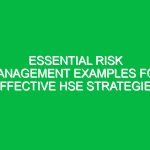Introduction
The risk of trip and fall incidents poses a significant challenge within the Health, Safety, and Environment (HSE) domain. Defined as any situation where an individual unintentionally trips over an object or uneven surface, often leading to injury, these occurrences can have dire consequences not only for the victim but also for organizations at large. In workplaces, the implications of such accidents can result in lost productivity, increased insurance premiums, legal liabilities, and a damaged reputation. This article delves into the critical risks associated with trip and fall incidents, emphasizing essential Safety Strategies that organizations can implement to mitigate these risks effectively.
Understanding the Risks of Trip and Fall
The risk of trip and fall incidents is multifaceted, encompassing various environmental, behavioral, and organizational factors. Understanding these components is vital for developing effective Prevention strategies.
Environmental Hazards
Environmental Hazards are often the most visible contributors to trip and fall incidents. These can include:
- Uneven flooring or surfaces
- Obstructed walkways
- Poor lighting
- Wet or slippery surfaces
- Improperly placed cords or cables
For instance, consider a manufacturing facility where workers navigate through narrow aisles filled with equipment. If these aisles are cluttered with tools or materials, the likelihood of a trip and fall increases significantly. Maintaining clear pathways and ensuring proper storage can drastically reduce these risks.
Behavioral Factors
Human behavior plays a crucial role in the risk of trip and fall accidents. Factors such as rushing, distractions, and lack of awareness can increase vulnerability. For example, an employee hurrying to meet a deadline may overlook a loose floor tile or a spill on the ground. Implementing Training programs that emphasize the importance of situational awareness can help mitigate these risks.
Organizational Factors
Organizations also bear responsibility for creating a safe environment. Poorly designed workspaces, inadequate Safety protocols, and insufficient Maintenance of facilities can all contribute to the risk of trip and fall incidents. Regular Safety audits and maintenance checks are essential in identifying potential hazards before they lead to accidents.
Best Practices for Mitigating Trip and Fall Risks
To effectively manage and reduce the risk of trip and fall incidents, organizations should adopt a comprehensive approach involving training, environmental modifications, and proactive Safety Measures.
Training and Awareness Programs
Education is a powerful tool in preventing accidents. By implementing training programs, organizations can equip employees with the knowledge to recognize hazards and practice safe behaviors. Regularly scheduled training sessions, combined with refresher courses, can instill a culture of safety within the workplace.
For example, a construction company might conduct monthly safety meetings where workers are encouraged to share experiences and discuss potential hazards encountered on the job site. This not only fosters communication but also enhances vigilance among workers.
Environmental Modifications
Creating a physically safe workspace is crucial. Organizations should conduct regular assessments of their facilities to identify and address hazards. Some effective environmental modifications include:
- Installing anti-slip flooring materials
- Ensuring adequate lighting in all areas
- Using clear signage to indicate potential hazards
- Providing adequate storage solutions to prevent clutter
For instance, many companies have implemented the use of colored tape to mark uneven surfaces or steps, effectively drawing attention to potential trip hazards.
Regular Maintenance and Inspections
Routine inspections and maintenance are vital for minimizing the risk of trip and fall incidents. A proactive approach ensures that any potential hazards are identified and addressed promptly. Organizations should:
- Schedule regular inspections of walkways and workspaces
- Promptly address maintenance issues, such as loose tiles or worn carpeting
- Ensure spills are cleaned up immediately
Consider a restaurant that routinely checks its dining area for spills or debris. By maintaining a clean and safe environment, they not only protect their patrons but also foster a culture of safety among staff.
Case Studies: Learning from Real-World Incidents
Exploring real-world incidents can provide valuable insights into the consequences of neglecting the risk of trip and fall.
Case Study 1: Manufacturing Facility
At a manufacturing facility, an employee suffered severe injuries after tripping over a loose electrical cord in a poorly lit area. The incident led to an investigation that revealed several safety violations, including inadequate lighting and lack of proper cord management protocols. Following the incident, the company implemented comprehensive safety training and invested in proper lighting and cord management solutions. This resulted in a significant reduction in trip and fall incidents over the following year.
Case Study 2: Retail Environment
In a retail store, a customer slipped on a wet floor due to a lack of signage and warning cones. The incident not only resulted in injury but also led to a lawsuit against the store. In response, the management revised their safety protocols to ensure that all spills were promptly addressed and that proper signage was displayed at all times. They also instituted regular safety training for staff, emphasizing the importance of immediate response to hazards.
Regulations and Standards Governing Trip and Fall Risks
Several Regulations and standards govern Workplace Safety, including the risk of trip and fall incidents. In the United States, the Occupational Safety and Health Administration (OSHA) sets forth guidelines that employers must follow to ensure a safe working environment. These guidelines emphasize the need for proper housekeeping, maintenance of walkways, and the necessity of addressing hazards promptly.
Additionally, the Americans with Disabilities Act (ADA) mandates accessibility standards that require organizations to ensure safe movement throughout their facilities. This includes providing adequate space for individuals with mobility aids, which can also contribute to overall safety by minimizing potential hazards.
Conclusion
The risk of trip and fall incidents is a critical concern within the HSE domain. By understanding the underlying causes and implementing effective safety strategies, organizations can significantly reduce these risks. Training, environmental modifications, and regular inspections are essential components of a robust safety program.
As we have seen through case studies and real-world examples, neglecting the risk of trip and fall can have serious consequences. Organizations must prioritize safety not only to protect their employees and customers but also to maintain their reputation and operational efficiency. By fostering a culture of safety, we can work towards minimizing these risks and ensuring a healthier, safer environment for all.
Effective management of the risk of trip and fall is not just a regulatory obligation; it is a commitment to the well-being of every individual in the workplace.


